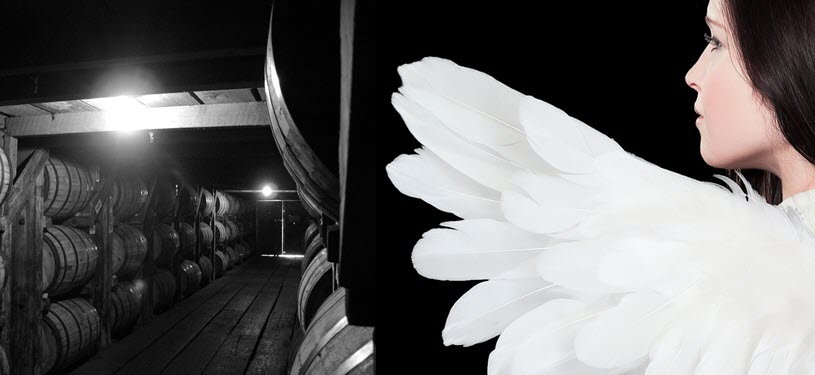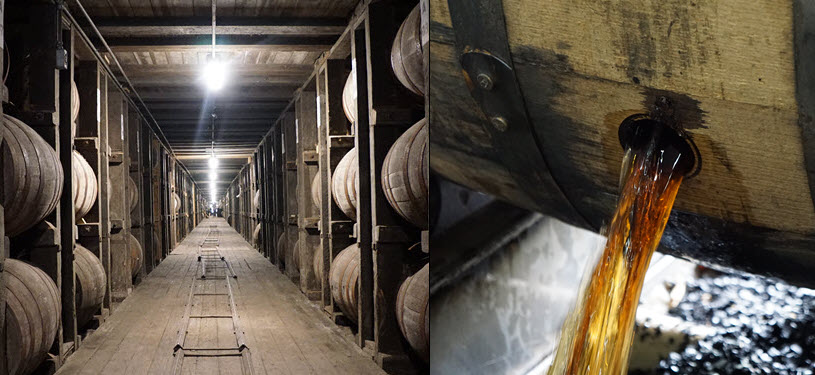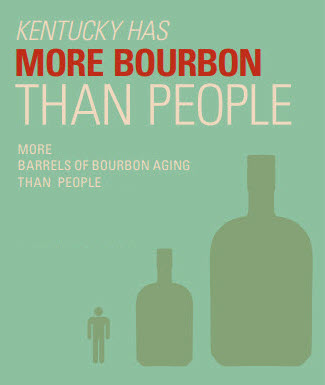
If Google Maps was able to do an angel overlay of the United States you would see a very large gathering of wings over Kentucky. Not because it’s in the center of the country, no the reason for this heavenly gathering is because of the states four seasons of heating and cooling and an underground labyrinth of limestone where water travels at a constant 56° degrees*. These components along with the mashing, cooking and fermenting of grains make up the perfect geographic location for the distilling and aging bourbon. Those angel’s are hovering over the state to collect their share of what’s coming off those barrels, the Angel’s Share.
For the first time since 1967 according to the state’s Department of Revenue data as of Jan. 1, 2019 Kentucky distillers now have more than 9.1 million barrels of spirits aging in warehouses across the state. To help put this in perspective just like there are two wings for every angel, there are now approximately two barrels of bourbon for every person in the state of Kentucky.
 Filling and Chilling 9.1 Million Barrels of Bourbon
Filling and Chilling 9.1 Million Barrels of Bourbon

The Kentucky Distillers’ Association has reported that the distilled spirits industry has set two modern era records. With the world’s thirst for bourbon Kentucky distillers filled more than 2.1 million barrels last year another record not seen since 1967. Add it up with the other barrels maturing in the state and there are now 9.1 million total barrels of spirits in Kentucky. Bourbon makes up 8.5 million or 93% of all barrels.
The previous record was 8.7 million total barrels in 1968 and 1.9 million barrels filled in 1967.

Kentucky Bourbon and distilled spirits is one of the state’s most historic and treasured industries, a thriving $8.6 billion economic engine that generates more than 20,100 jobs with an annual payroll topping $1 billion, according to a study announced earlier this year.
Bourbon production has skyrocketed more than 350 percent since the turn of the century, triggering a $2.3 billion building boom, expanding production and warehouse capabilities and pioneering advanced visitor centers that are significantly elevating Kentucky’s tourism profile.
Bourbon tourists made a record 1.4 million distillery stops in 2018 – a 370 percent increase over the last 10 years. The Kentucky Bourbon Trail tour alone logged one million visits for the first time since its creation in 1999. The Kentucky Bourbon Trail Craft Tour tallied another 340,000 distillery stops, the most since its founding in 2012.
Threats to the Distilled Spirits Industry – Tariffs & Taxes
Despite these record-breaking statistics, Gregory warned there are a few gray clouds.
Escalating tariffs and never-ending trade wars continue to pose serious threats to global exports of Kentucky Bourbon, especially to EU countries, the largest market. The Association recently joined other world whiskey associations in calling for an immediate return to free and fair trade.
Related Stories
Steep 25% U.S. Tariffs Imposed on Distilled Spirits and Wine from Eastern European Take Effect
What is the Angel’s Share?
The announcement of historic barrel inventories should not be interpreted as an allaying of those fears, Gregory said. Distillers had hoped that the trade wars would be a short-term challenge, and barrels filled last year won’t be matured and bottled for several more years.
Kentucky Bourbon exports had been increasing an average of 25% a year since 2016, but have dropped 20 points through August of this year. EU exports, which had been averaging 38% growth, have plummeted to -1% through August compared to the same time last year.
“Kentucky Bourbon is collateral damage in a trade dispute that has nothing to do with us,” he said. “While we remain hopeful for a resolution soon, the impact on our industry, our partners and our farm families is significant and growing.”
The tax-assessed value of all aging barrels is now $3.4 billion, double the rate since 2009. Distilling remains the highest taxed of all 532 industries in the state, Gregory said, and distillers this year are paying a record $25 million in barrel taxes, a tax that hampers growth and investment.
Kentucky is the only place in the world that taxes aging barrels of spirits. This discriminatory inventory tax on Bourbon is already having an impact on the number of distilleries locating in the Commonwealth, which now ranks 13th in the country in the number of operating distilleries.
Stay Informed: Sign up here for the Distillery Trail free email newsletter and be the first to get all the latest news, trends, job listings and events in your inbox.
“Kentucky needs to protect its signature industry and not let it become economically uncompetitive and disadvantaged for tax and regulatory reasons,” Gregory said. “Kentucky cannot afford to lose its historic distilling monopoly.”
The Kentucky General Assembly passed the Bourbon Barrel Reinvestment Credit in 2014, which sought to offset the barrel tax by giving distilleries a credit against their corporate income taxes and requiring the money to be reinvested in their Kentucky facilities.
The credit has helped spur tremendous growth, Gregory said, but rapidly increasing barrel taxes are now far outpacing the amount of corporate income tax credit that’s allowed, particularly since the legislature lowered the corporate rate last year.
Gregory reiterated the call for lawmakers to make the credit refundable. “Just think of the jobs, revenue and investment we would create and attract if distilleries could realize the full benefit of the barrel credit,” he said.
“We are grateful that policymakers recognize the vital role this homegrown industry plays in jobs, revenue and tourism, but we should not have a tax structure that penalizes increased production and capital investment on any manufacturer,” he said.
The Kentucky Distillers’ Association is a non-profit trade association founded in 1880 to promote, protect and elevate Kentucky’s signature Bourbon and distilled spirits industry.
See all Kentucky Distilleries.
* Source: U. S. Geol. Survey Water-Supply Paper 164, p. 117, 1906.
Please help to support Distillery Trail. Sign up for our Newsletter, like us on Facebook and follow us on Twitter.




